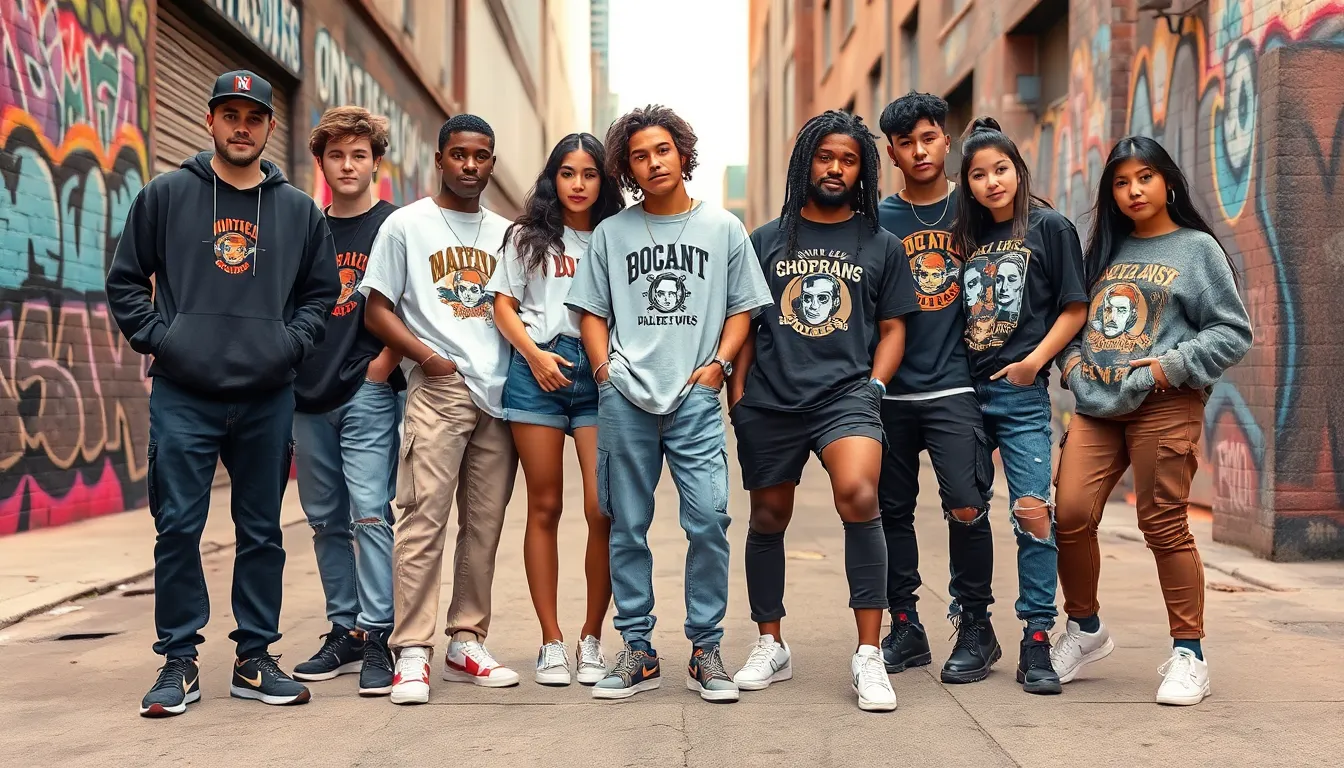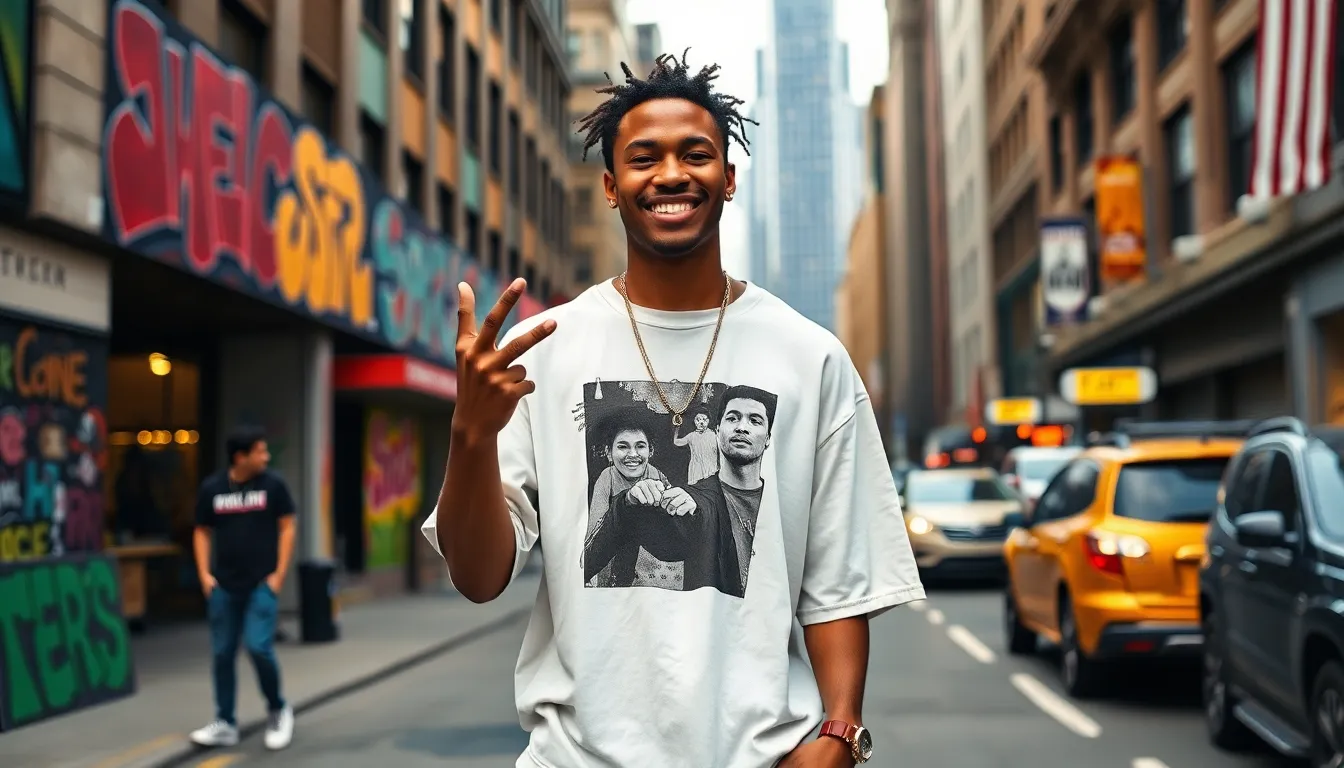Table of Contents
ToggleStreetwear culture has transformed the fashion landscape, blending urban influences with high-end aesthetics. Originating from the skate and hip-hop scenes, it’s more than just clothing; it’s a lifestyle that embodies self-expression and community. As brands like Supreme and Off-White rise to prominence, the lines between streetwear and luxury fashion continue to blur, captivating a diverse audience.
This dynamic culture thrives on creativity and individuality, with enthusiasts constantly pushing boundaries through unique designs and collaborations. Whether it’s a graphic tee or limited-edition sneakers, streetwear reflects a sense of belonging and rebellion. As it evolves, streetwear not only shapes personal style but also influences broader trends in the fashion industry, making it a fascinating topic for exploration.
Overview Of Streetwear Culture
Streetwear culture embodies a blend of influences from skateboarding, hip-hop, and youth subcultures. Emerging in the late 20th century, it prioritizes self-expression and community over traditional fashion norms. Notably, brands like Supreme and Off-White have fostered a climate where the lines between streetwear and luxury fashion become indistinct.
Cultural significance lies in its emphasis on individuality and creativity. Streetwear enthusiasts regularly engage in collaborations that challenge conventional design. High-profile partnerships between streetwear brands and established luxury houses highlight this evolution, showcasing how innovation drives the industry forward.
The culture garners interest from a wide demographic, with its appeal rooted in the exclusivity of limited releases and the vibrant storytelling behind each piece. Underground movements play a crucial role, allowing emerging designers to showcase their visions and push boundaries.
Overall, streetwear transcends simple fashion, influencing broader trends and lifestyles while fostering a sense of identity among its community.
History Of Streetwear Culture

Streetwear culture traces its roots to the late 20th century, reflecting a confluence of style, music, and social movements. Understanding its origins and evolution highlights the cultural shifts that shaped this influential fashion genre.
Origins And Influences
Streetwear emerged from the fusion of skateboarding and hip-hop culture during the 1980s. Influential skate brands like Stüssy began incorporating graphics and logos into casual wear, appealing to youth seeking identity and rebellion. Hip-hop artists also played a crucial role by promoting oversized clothing and bold designs that resonated with their audiences. Collaboration between these cultures fostered a sense of community, creating a platform for self-expression.
Evolution Over The Decades
The 1990s marked a significant shift, as streetwear evolved into a recognized fashion trend. Designers like Ralph Lauren and brands like FUBU integrated street aesthetics into mainstream fashion. By the 2000s, lines between streetwear and luxury blurred, highlighted by the emergence of brands like A Bathing Ape and the collaboration of Kanye West with major fashion houses. The 2010s saw an explosion of streetwear brands, driven by social media, which facilitated accessibility and real-time engagement. High-profile partnerships with luxury brands, such as Supreme’s collaboration with Louis Vuitton, reinforced streetwear’s cultural clout and transformed it into a global phenomenon.
Key Elements Of Streetwear Culture
Streetwear culture incorporates distinct elements that reflect its origins and evolution. These factors contribute to the vibrant community and style associated with streetwear.
Fashion Aesthetics
Fashion aesthetics in streetwear prioritize comfort and functionality while embracing bold visuals. Key characteristics include:
- Oversized fits: Clothing often features relaxed silhouettes, providing a sense of ease and a casual look.
- Graphic tees: T-shirts adorned with striking graphics, logos, and messages play a central role in self-expression.
- Street-inspired accessories: Accessories like caps, backpacks, and sneakers complement the overall look, often displaying brand insignias or unique designs.
- Layering techniques: Combining different pieces, such as hoodies under jackets or shirts over shirts, showcases personal style and creativity.
This fashion aesthetic fosters individual expression, allowing wearers to convey their identity through unique outfits.
Iconic Brands And Collaborations
Numerous brands and collaborations significantly shape streetwear culture. These influential players include:
- Supreme: Established in 1994, this brand epitomizes streetwear, known for its limited drops and high-demand items. Its collaborations with luxury brands like Louis Vuitton reinforce its status.
- Off-White: Founded by Virgil Abloh in 2012, Off-White integrates streetwear with high fashion, characterized by distinctive branding and design elements.
- Stüssy: One of the original streetwear brands, Stüssy reflects surf culture and urban aesthetics, greatly impacting the genre’s development.
- Collabs: Projects like Adidas x Yeezy and Nike x Travis Scott highlight the trend of collaborative efforts, merging cultural influences and producing sought-after items.
These brands and collaborations not only set trends but also enhance the storytelling aspect of streetwear, connecting communities through shared styles and values.
The Role Of Social Media In Streetwear Culture
Social media serves as a central platform for streetwear culture, driving trends and fostering community engagement. Various platforms amplify voices and showcase styles that shape consumer tastes and industry dynamics.
Platforms That Shape Trends
- Instagram: Instagram showcases high-quality visuals and aesthetic content, making it a primary platform for streetwear brands and influencers. Streetwear enthusiasts share outfit inspirations and product releases, influencing followers’ purchasing behaviors.
- TikTok: TikTok’s algorithm enables rapid spread of trend-specific content. Viral challenges and hashtag campaigns allow streetwear brands to reach younger audiences, promoting unique styles and fostering user participation.
- Twitter: Twitter provides a space for real-time conversations and announcements. Brands can engage directly with consumers, share limited drops, and communicate brand narratives swiftly, impacting how trends are perceived and adopted.
- YouTube: YouTube features fashion reviews, lookbooks, and styling tips, enhancing brand visibility. Influencers generate discussions around product launches and collaborations, leading to increased consumer interest and excitement.
Impact On Consumer Behavior
- Awareness and Accessibility: Social media raises awareness of new brands and collections, making streetwear more accessible to wider audiences. Consumers can discover niche brands alongside established labels, reshaping their shopping choices.
- FOMO and Exclusivity: Fear of missing out (FOMO) drives urgency in consumer behavior. Limited edition releases and exclusive collaborations are heavily promoted through social media, prompting quick buying decisions among followers.
- Community Building: Social media encourages the formation of communities around shared interests. Consumers engage in discussions and collaborations, reinforcing loyalty to specific brands and creating a sense of belonging.
- Influencer Culture: Influencers shape consumer preferences through strategic partnerships with brands. Followers often emulate their styles, which significantly impacts purchasing patterns and brand popularity within the streetwear space.
Future Of Streetwear Culture
Streetwear culture continues to evolve, influenced by trends, consumer values, and global events. Emerging dynamics shape its trajectory, creating opportunities for innovation and expression.
Upcoming Trends To Watch
Streetwear culture is set to embrace several upcoming trends, including:
- Tech Integration: Wearable technology, including smart clothing and augmented reality, enhances user experiences and personalization.
- Gender Fluidity: Blurring the lines between men’s and women’s fashion allows for more inclusive designs and styles.
- Digital Fashion: Virtual clothing for online avatars and gaming characters reflects growing interest in digital clothing markets.
- Retro Revival: Nostalgic styles from the 1990s and early 2000s will resurface, appealing to both older and younger generations.
- Collaborative Collections: Increased collaborations between diverse brands and artists will continue to redefine aesthetics and target various audiences.
Sustainability And Ethical Considerations
Sustainability has become a focal point for streetwear culture, emphasizing ethical practices and eco-conscious materials. Key considerations include:
- Sustainable Materials: Brands will increasingly utilize organic cotton, recycled fabrics, and innovative textiles to reduce environmental impact.
- Local Production: Shifting towards localized manufacturing will minimize carbon footprints and support community economies.
- Transparent Supply Chains: Fair labor practices and transparency will foster consumer trust, with brands highlighting their commitment to ethical production.
- Circular Fashion: Initiatives promoting clothing recycling, upcycling, and resale will gain traction, encouraging extended garment life cycles.
- Minimalism: A shift toward minimalist designs will reflect consumer desire for timeless pieces over fast fashion trends.
These factors will likely underpin the future direction of streetwear culture, influencing both brands and consumers in meaningful ways.
Streetwear culture stands as a powerful force in the fashion landscape. Its roots in skate and hip-hop have blossomed into a vibrant lifestyle that champions individuality and community. As it continues to evolve, streetwear embraces emerging trends and consumer values, ensuring its relevance in a rapidly changing world.
The integration of technology and sustainability reflects a forward-thinking mindset that resonates with today’s conscious consumers. With influential brands and dynamic collaborations leading the charge, streetwear remains a compelling narrative that shapes personal style and broader cultural movements. As it forges ahead, the community’s passion and creativity will undoubtedly keep streetwear at the forefront of fashion innovation.






